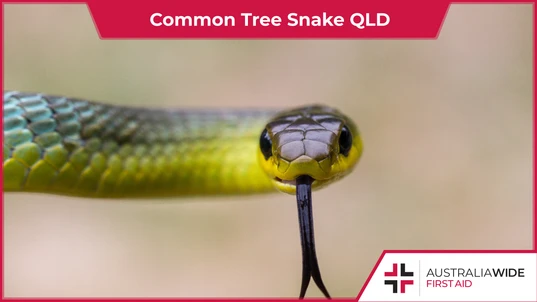Common Tree Snake QLD

Bites and Stings

The Common tree snake is one of the most common snakes encountered in Brisbane and wider south east Queensland (QLD). They are regularly encountered in homes and suburban gardens, where they use an interesting defence to deter any potential threats.
The Common tree snake is one of the most regularly encountered snakes in Brisbane and along the coastline of south east Queensland (QLD). They are also one of the most common snake species to enter homes. Continue reading for more information about QLD's Common tree snake, and what to do if you encounter one. We also cover snake bites in our general and child care first aid courses - we have training locations in Brisbane and in every other state, capital city, and major town throughout Australia. Head to our website to enrol in a course near you today.Appearance
QLD's Common tree snake has the following characteristics:- Slender body with an average length of 1.2 metres, but a specimen of 1.96 metres has been recorded
- Midbody scale rows 13 (the number of scales you can count at the widest part of the snake's body when it is 'sitting' on the ground)
- Their eyes appear large comparative to their head
- The scales on their upper body can vary dramatically, with the colour ranging from black or brown to green or yellow
- A distinctive ridge along the outer edges of their belly
- Their underbelly tends to be cream or yellow, with yellow flushing on the throat. Some rare specimens have a blue or grey belly, though they generally maintain the yellow coloration above the ventral ridges
Distribution
QLD's Common tree snake is one of the most common species in Brisbane, where it can be found in the following habitats:- Rainforest
- Wet sclerophyll forest
- Dry woodland and rural land
Danger
QLD's Common tree snake is non-venomous, inoffensive, and only bites infrequently, though they do use a foul smell musk to deter any potential threats. It can be difficult to positively identify different snake species, as individuals of the same species can vary dramatically in colour, pattern, and size. As such, all snake bites should be treated as a medical emergency. If you or someone else is bitten by a snake, call Triple Zero (000) for emergency services and apply a pressure bandage as part of the Pressure Immobilisation Technique. It is important to remember that snake bites rarely cause fatalities, as modern anti venoms are typically effective at neutralising most snake bites. Likewise, snakes will never go out of their way to attack you - they will generally only bite people when threatened or provoked. As such, if you encounter a snake, do not attempt to approach, capture, or kill it. If you need a snake relocated from your home, contact a snake catcher instead.Final thoughts
To learn more about treating and preventing snake bites, enrol in one of our general or childcare first aid courses - we have training locations in Brisbane and in every other state, capital city, and major town throughout Australia. Head to our website to find a course near you today!
Originally published at
https://www.australiawidefirstaid.com.au/resources/common-tree-snake-qld
as part of the Australia Wide First Aid Articles Library









